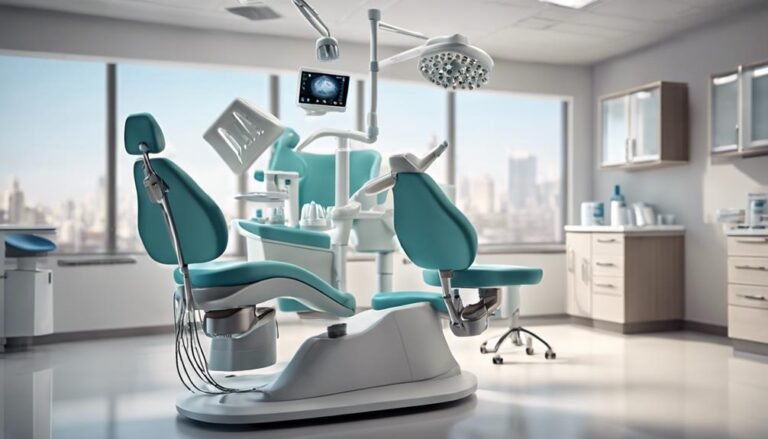Suture Technology Advances: A Review of Modern Surgical Threads"
Explore the domain of suture technology advances with modern surgical threads. Evolution from natural to synthetic polymers has transformed wound closure techniques. Enhanced thread strength and durability revolutionize surgical procedures. Biocompatible coatings reduce inflammation and infection risks. Absorbable threads provide temporary support while non-absorbable offer long-lasting strength. Novel designs increase precision and maneuverability during stitching. The future holds promises of nanotechnology integration and smart sutures for real-time monitoring. Stay informed on the latest innovations shaping surgical wound closures to optimize outcomes.
Key Takeaways
- Evolution from natural to synthetic materials enhances wound closure techniques.
- Innovative thread materials offer enhanced strength and durability for surgical procedures.
- Biocompatible coatings improve thread performance and biocompatibility.
- Absorbable threads degrade over time, while non-absorbable threads provide long-lasting support.
- Novel thread designs and configurations enhance surgical stitching precision and wound support.
Evolution of Suture Materials
In modern surgical practices, the evolution of suture materials has greatly enhanced the efficacy and outcomes of various procedures. Historical developments have seen a significant shift from natural materials like silk and catgut to modern synthetic polymers such as polyglycolic acid (PGA), polyglactin, and polydioxanone. These advancements have revolutionized wound closure techniques by providing increased tensile strength, better handling characteristics, and reduced tissue reactivity.
Material composition plays an important role in the performance of surgical sutures. For instance, PGA sutures offer high tensile strength early in the healing process but can cause tissue reactivity. On the other hand, polyglactin sutures provide a balance between strength and absorption rate. Polydioxanone, with its excellent handling and long absorption time, is suitable for cardiovascular and plastic surgery applications. Understanding the properties of different suture materials is essential for selecting the most appropriate type based on the specific requirements of each surgical procedure.
Enhanced Thread Strength and Durability
You need to take into account the innovative thread materials and their impact on surgical procedures.
These advancements greatly enhance the strength and durability of sutures, leading to improved outcomes in various surgeries.
Understanding the role of enhanced thread strength and durability is vital for optimizing patient care and surgical success.
Thread Material Innovation
Advancements in suture technology have led to the development of thread materials with enhanced strength and durability, revolutionizing the field of surgical stitching. These modern threads offer exceptional biodegradability and sustainability, ensuring that they degrade naturally over time, reducing the need for removal surgeries. Additionally, the threads exhibit remarkable flexibility and maneuverability, allowing surgeons precise control during intricate stitching procedures.
The enhanced strength of these innovative materials contributes to better wound support and closure, leading to improved patient outcomes and reduced risk of post-operative complications. Surgeons can now rely on these durable threads to withstand tension without compromising their structural integrity, providing long-lasting support to healing tissues. In addition, the incorporation of advanced materials in thread manufacturing has significantly increased their tensile strength and resistance to breakage, making them reliable tools in various surgical settings.
Impact on Surgeries
With enhanced thread strength and durability, modern suture technology has greatly improved the outcomes of surgical procedures. The increased strength of surgical threads allows for better wound support, reducing the risk of wound dehiscence and postoperative complications. This advancement is particularly important in surgeries that involve high tension or stress on the incision site, such as orthopedic procedures or abdominal surgeries.
The enhanced durability of modern surgical threads also contributes to improved patient outcomes by ensuring that the sutures remain intact throughout the critical phases of wound healing. This durability minimizes the need for suture removal or replacements, which can reduce the risk of infection and scarring while promoting faster and more efficient wound closure.
Moreover, the cost-effectiveness of these advanced threads shouldn't be overlooked. By reducing the likelihood of complications and the need for additional interventions, modern sutures ultimately lead to reduced healthcare costs and improved overall surgical outcomes. Surgical techniques have also evolved to capitalize on the strength and durability of modern threads, allowing for more precise and effective wound closure methods.
Biocompatible Thread Coatings
Biocompatible thread coatings play an important role in enhancing the biocompatibility and performance of surgical threads during medical procedures. These coatings often consist of a resorbable layer that gradually breaks down over time, reducing the risk of inflammation or rejection by the body. Additionally, some biocompatible coatings are designed with antimicrobial properties, helping to prevent infections at the surgical site.
The use of a resorbable coating on surgical threads is essential for minimizing tissue trauma during the healing process. As the coating dissolves, it decreases the chances of causing irritation or foreign body reactions within the patient's body. Furthermore, the incorporation of antimicrobial properties in these coatings provides an added layer of protection against potential post-operative infections, which can greatly impact the patient's recovery and outcome.
Absorbable Vs. Non-Absorbable Threads
When selecting between absorbable and non-absorbable threads, it's important to take into account the absorption rates and material longevity. Absorbable threads are designed to degrade over time, providing temporary support during healing, while non-absorbable threads offer long-lasting tensile strength.
Understanding these differences is vital for choosing the most suitable suture material for each surgical application.
Absorption Rates Comparison
The examination of absorption rates between absorbable and non-absorbable threads in modern suture technology is essential for determining their effectiveness in surgical applications.
Absorbable threads, such as those made from polyglycolic acid or polydioxanone, degrade over time through hydrolysis, offering suitable absorption kinetics that align with the wound healing process. These threads provide temporary support to the tissue and eventually lose their tensile strength as absorption occurs.
In contrast, non-absorbable threads, like those constructed from nylon or polypropylene, maintain their tensile strength over time and aren't metabolized by the body. The choice between absorbable and non-absorbable threads depends on factors such as the required duration of wound support and the potential inflammatory response.
Absorbable threads may reduce the need for suture removal procedures, while non-absorbable threads are preferred in situations where long-term wound support is necessary. Understanding the absorption rates of these threads is essential for optimizing surgical outcomes and promoting efficient wound healing.
Material Longevity Considerations
Consider the lifespan of the surgical threads when deciding between absorbable and non-absorbable options for best wound management and healing outcomes. The choice between absorbable and non-absorbable threads greatly impacts long-term performance and degradation resistance.
Absorbable threads are designed to degrade over time within the body, offering temporary support during the critical healing period. These threads are often preferred for internal sutures where removal would be challenging or detrimental. However, the degradation process of absorbable threads must align with the wound healing timeline to prevent premature loss of tissue support.
On the other hand, non-absorbable threads provide long-lasting strength and stability but may require removal after the wound has healed. Factors such as the patient's healing rate, tissue type, and infection risk should guide the selection between absorbable and non-absorbable threads to optimize wound closure outcomes.
Understanding the material longevity considerations of surgical threads is essential for achieving successful wound management and promoting effective healing.
Novel Thread Designs and Configurations
Innovative thread designs and configurations offer enhanced surgical precision and efficiency in modern suture technology. The evolution of suture materials has led to the introduction of novel thread shapes that cater to specific surgical requirements. Surgeons can now choose from a variety of innovative thread shapes such as barbed, knotless, and self-retaining threads, each designed to optimize tissue apposition and reduce operative time.
Thread customization techniques allow for tailoring the thread properties to match the tissue type and surgical procedure, enhancing overall wound healing outcomes. By utilizing these advanced thread designs and configurations, surgeons can achieve improved tensile strength, reduced tissue trauma, and more secure knots. Additionally, the use of innovative threads enables better handling characteristics, promoting smoother tissue passage and minimizing the risk of tissue damage.
Incorporating these advancements in suture technology enhances the overall surgical experience for both the patient and the surgical team.
Future Trends in Suture Technology
With advancements in material science and bioengineering, suture technology is poised to revolutionize surgical procedures in the near future. Robotic assistance is one of the key future trends in suture technology. Robots equipped with precision stitching capabilities can enhance the accuracy and consistency of suturing, leading to improved surgical outcomes and reduced complications.
Another significant trend on the horizon is the integration of nanotechnology into sutures. Nanotechnology integration allows for the development of smart sutures that can actively monitor wound healing processes. These smart sutures can provide real-time feedback on the healing status, detect infections at an early stage, and even deliver medications directly to the wound site as needed, promoting faster and more efficient recovery.
Conclusion
You have just scratched the surface of the advancements in suture technology.
Did you know that the global surgical suture market is projected to reach $5.58 billion by 2027?
With innovations in thread strength, durability, coatings, and designs, surgeons now have a wide array of options to choose from for improved patient outcomes.
Stay tuned for more exciting developments in the field of suture technology.







